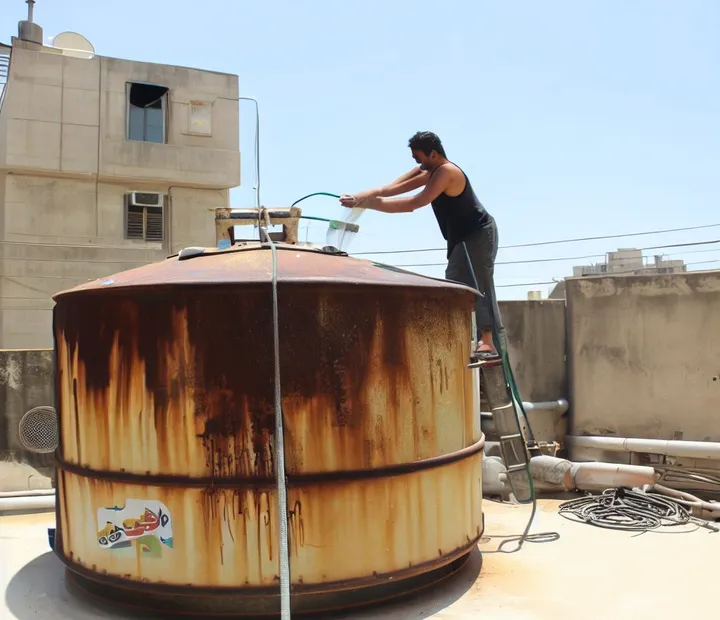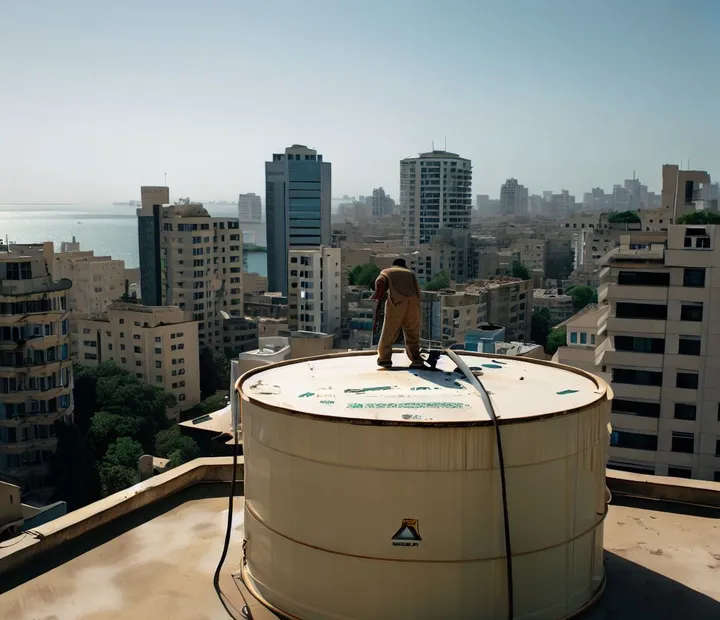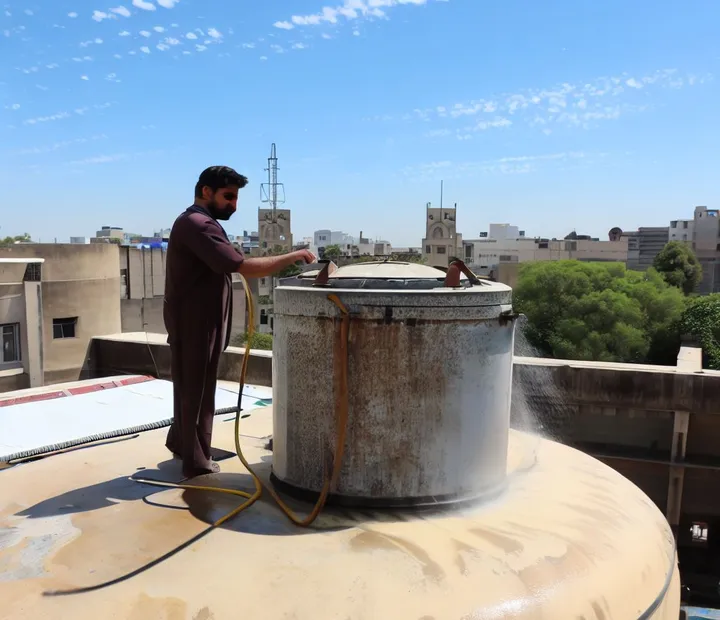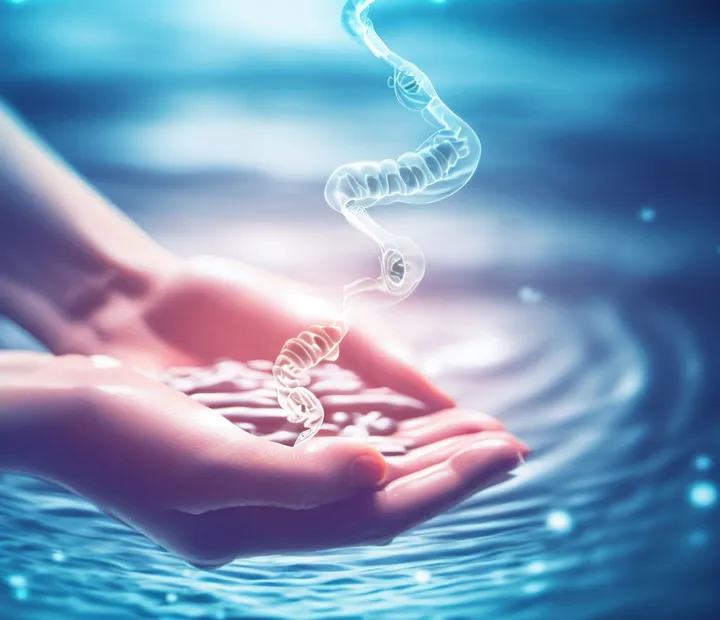Karachi, the largest city in Pakistan, has a tropical desert climate with a partial, intermittent influence of the Indian monsoon from July to September. The city is located on the coast of the Arabian Sea and experiences a high level of humidity and salinity in the air.
The monsoon rains bring relief from the scorching heat but also pose challenges to the water supply and quality. Water tanks, which are widely used for storing water for domestic and commercial purposes, need to be properly maintained and cleaned to prevent contamination and health risks.

Why is water tank cleaning important?
Water tank cleaning is important for several reasons:
- Water tanks can accumulate dirt, dust, algae, bacteria, viruses, fungi, insects, rodents, and other pollutants over time. These contaminants can affect the taste, smell, color, and quality of the water. They can also cause corrosion and damage to the tank and its fittings.
- Contaminated water can pose serious health risks to consumers. Waterborne diseases such as diarrhea, typhoid, cholera, hepatitis, dysentery, and skin infections can be transmitted through drinking or using unclean water. Children, elderly people, and people with weak immune systems are especially vulnerable to these diseases.
- Water tank cleaning can improve the efficiency and lifespan of the tank and its components. It can also reduce the water wastage and save energy costs.
How to prepare your water tank for the monsoon season?
The monsoon season in Karachi is expected to begin from mid-July and last until mid-September. The average rainfall in Karachi for the monsoon season is 131.9 millimeters, which is expected to rise to 140 mm this year.
The pre-monsoon season is expected to start in the second week of June and monsoon rains are expected in the last week of June. Therefore, it is advisable to prepare your water tank for the rainy season before it starts.
Here are some steps you can take to prepare your water tank for the monsoon season:
- Check your water tank for any leaks, cracks, holes, rust, or damage. Repair or replace any faulty parts as soon as possible.
- Check your water tank lid and make sure it is tightly sealed and secured. A loose or broken lid can allow rainwater, dust, insects, or animals to enter the tank and contaminate the water.
- Check your water pipes and valves for any blockages, leaks, or corrosion. Clean or replace them if needed.
- Check your water filter and make sure it is working properly. Replace the filter cartridge if it is dirty or expired.
- Drain your water tank completely and clean it thoroughly. You can use a professional water tank cleaning service or do it yourself by following these steps:
- Turn off the water supply and disconnect the pipes from the tank.
- Use a pump or a bucket to empty the tank completely.
- Scrub the inside walls and floor of the tank with a brush or a sponge dipped in a mild detergent solution. You can also use a disinfectant solution such as chlorine bleach or hydrogen peroxide to kill any germs or algae.
- Rinse the tank with clean water several times until there is no residue left.
- Dry the tank with a cloth or a fan.
- Reconnect the pipes and turn on the water supply.
- Fill the tank with clean water and flush it through the pipes and faucets until there is no smell or taste of detergent or disinfectant.
How to maintain your water tank during the monsoon season?
Once you have prepared your water tank for the monsoon season, you need to maintain it regularly to ensure its cleanliness and safety. Here are some tips on how to maintain your water tank during the monsoon season:
- Monitor your water quality regularly. You can use a simple test kit or a digital meter to check the pH level, turbidity level, chlorine level, hardness level, and microbial count of your water. You can also send a sample of your water to a laboratory for more accurate testing.
- If you notice any changes in the color, smell, taste, or appearance of your water, do not use it for drinking or cooking. Boil it before using it or use bottled water instead.
- If you suspect that your water is contaminated with harmful microorganisms such as bacteria or viruses, disinfect it by adding chlorine bleach or hydrogen peroxide according to the manufacturer’s instructions. You can also use ultraviolet (UV) light or ozone generators to disinfect your water.
- Clean your water tank at least once every three months or more frequently if needed. Follow the same steps as mentioned above for preparing your water tank for the monsoon season.
- Keep your surroundings clean and hygienic. Dispose of your garbage properly and avoid littering or dumping waste near your water tank. Keep your pets and animals away from your water tank. Cover any open drains or sewers near your water tank to prevent the entry of rainwater or sewage water into the tank.
- Avoid storing rainwater in your water tank unless you have a proper rainwater harvesting system. Rainwater can carry dust, pollutants, chemicals, or pathogens from the air or the roof and contaminate your water tank. If you want to use rainwater, make sure you filter it and disinfect it before storing it in your water tank.
Conclusion
Water tank cleaning and maintenance are essential for protecting your water quality and health during the monsoon season in Karachi. By following the tips and steps mentioned above, you can prepare and maintain your water tank for the rainy season and enjoy clean and safe water throughout the year.

Dr. Ahmed is a renowned entomologist with over 20 years of experience in studying insects. He obtained her Bachelor’s degree in Biology from the University of Punjab, and then completed his Master’s and Ph.D. in Entomology from the University of the Punjab.
Dr. Ahmed has conducted extensive research on the behavior, ecology, and evolution of insects. His work has been published in numerous peer-reviewed scientific journals and has been presented at international conferences. He has also served as a consultant for various organizations, including government agencies and private companies.







